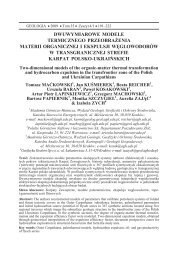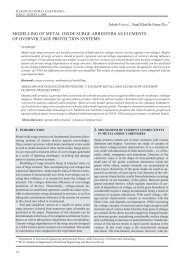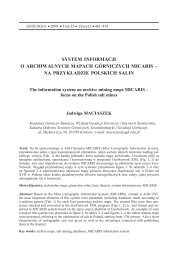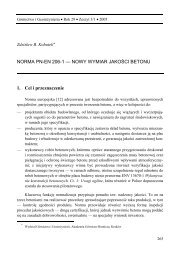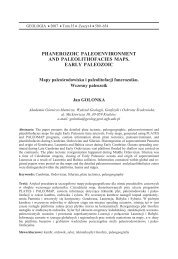Create successful ePaper yourself
Turn your PDF publications into a flip-book with our unique Google optimized e-Paper software.
140 J. Wachowiak, M. Pawlikowski & P. Wilkosz<br />
a larger blastic force, built between halite blasts euhedrally formed blasts, in the form of<br />
elongated poles and slats, several to about a dozen millimetres long, laid in parallel to the<br />
contact area with salt, created the directional- at- parallel texture (Fig. 7F). Inside the rock,<br />
in the zone of limited freedom of recrystallization, anhydrite grains with similar blastesis<br />
power formed a granoblastic structure composed of anhedral blasts (Fig. 7E). Flat-paralleldirectional<br />
texture of the anhydrite rock was a clear symptom of recrystallization under pressure,<br />
resulting from halotectonic processes.<br />
<br />
<br />
<br />
Fig. 9. X-Ray diffraction patterns of carbonate-clay substance, extracted from dark-grey lamina in Anhydrite.<br />
Main Anhydrite (A-3), Sample No. 17/1267, Mogilno Salt Diapir: A – Anhydrite, Chl – Chlorite,<br />
Mg – Magnesite, Q – Quartz<br />
Fig. 9. Dyfraktogram rentgenowski substancji wglanowo-ilastej pobranej z ciemnoszarej laminy wystpujcej<br />
w anhydrycie. Anhydryt gówny (A-3), próbka 17/1267: Chl – chloryt, Q – kwarc, A – anhydryt,<br />
Mg – magnezyt<br />
Close to the anhydrite block boundaries, there appeared epigenetic brous halite veins<br />
and several centimetre long, epigenetic crystal halite nests, with milky-greenish ne-crystalline<br />
polyhalite.



